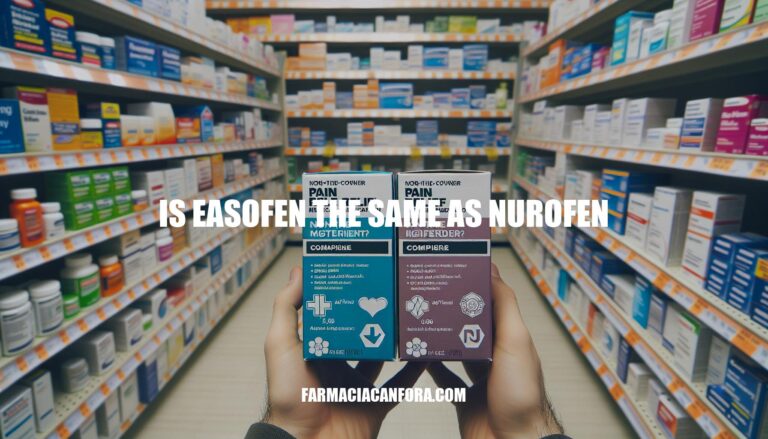This article aims to determine if Easofen and ibuprofen-and-aleve-the-same-thing”>Nurofen are the same. Both medications are commonly used to relieve pain and reduce inflammation. Easofen and ibuprofen-and-naproxen-the-same”>Nurofen contain ibuprofen, a nonsteroidal anti-inflammatory drug (NSAID) effective for treating headaches, muscle pain, and fever. By comparing these two brands, we will clarify any differences and help you make an informed choice.
Active Ingredients
Easofen and Nurofen both contain ibuprofen as their active ingredient. Ibuprofen is a non-steroidal anti-inflammatory drug (NSAID) used to reduce pain, inflammation, and fever.
How Ibuprofen Works:
- Pain Relief: Ibuprofen blocks the enzyme cyclooxygenase (COX), which is involved in the production of prostaglandins. Prostaglandins are chemicals in the body that promote inflammation, pain, and fever. By inhibiting COX, ibuprofen reduces the levels of prostaglandins, thereby decreasing pain and inflammation.
- Inflammation Reduction: The reduction in prostaglandins also helps to lower inflammation, making ibuprofen effective for conditions like arthritis, muscle aches, and other inflammatory conditions.
Brand vs. Generic
Formulation:
- Easofen: Contains ibuprofen as the active ingredient.
- Nurofen: Also contains ibuprofen as the active ingredient. However, Nurofen has marketed specific formulations like Nurofen Migraine Pain, Nurofen Tension Headache, etc., which all contain the same active ingredient but are marketed for different types of pain.
Packaging:
- Easofen: Typically comes in standard, no-frills packaging.
- Nurofen: Uses distinct, color-coded packaging for different pain types (e.g., violet for Migraine Pain, burgundy for Tension Headache) to create a perception of targeted pain relief.
Marketing:
- Easofen: Marketed as a cost-effective, generic alternative to branded ibuprofen.
- Nurofen: Employs a segmented marketing strategy, promoting different products for specific types of pain, which has been criticized as misleading since the formulations are identical.
Effectiveness
Easofen and Nurofen are both ibuprofen-based medications used to treat pain and inflammation. They are essentially the same in terms of their active ingredient, ibuprofen, which is a nonsteroidal anti-inflammatory drug (NSAID).
Effectiveness:
- Easofen: Generally considered effective for pain relief and reducing inflammation. User reviews suggest it works well and is often chosen for its cost-effectiveness.
- Nurofen: Also highly effective, with a well-established reputation. It is often preferred for its brand reliability and consistent results.
Studies:
- A bioequivalence study concluded that different ibuprofen formulations, including Nurofen, are bioequivalent in terms of absorption and effectiveness. This implies that Easofen, being a generic version, should perform similarly to Nurofen.
User Reviews:
- Easofen: Users often mention it as a cheaper alternative to Nurofen, with similar effectiveness.
- Nurofen: Users appreciate its reliability and effectiveness, though it is generally more expensive than Easofen.
In summary, both Easofen and Nurofen are effective for treating pain and inflammation, with the main difference being cost and brand preference.
Price Comparison
Easofen and Nurofen are both brands of ibuprofen, a common nonsteroidal anti-inflammatory drug (NSAID). Here’s a comparison of their prices and any significant differences:
Price Comparison
- Easofen: Generally, Easofen is priced lower than Nurofen. For example, a pack of 24 Easofen tablets (200 mg) might cost around €3-€4.
- Nurofen: Nurofen tends to be more expensive, with a similar pack of 24 tablets (200 mg) costing around €5-€6.
Significant Differences
- Branding and Packaging: Nurofen is a well-known brand with extensive marketing, which can contribute to its higher price. Easofen, being a less marketed brand, is cheaper.
- Formulations: Nurofen offers a wider range of formulations, including specific products for different types of pain (e.g., Nurofen Migraine, Nurofen Express). Easofen typically offers standard ibuprofen tablets.
- Perceived Effectiveness: Some users report that they find Nurofen more effective, possibly due to the placebo effect associated with its branding.
Justification of Higher Cost
The higher cost of Nurofen is primarily due to its branding, marketing, and the variety of formulations available. While the active ingredient (ibuprofen) is the same in both Easofen and Nurofen, the perceived effectiveness and trust in the brand can justify the higher price for some consumers.
Easofen vs Nurofen: A Comparison of Two Similar Medications
Easofen and Nurofen are essentially the same in terms of their active ingredient, ibuprofen, which is a nonsteroidal anti-inflammatory drug (NSAID). They share similar effectiveness for pain relief and reducing inflammation, with the main difference being cost and brand preference.
Easofen is generally priced lower than Nurofen due to its less marketed branding and standard formulations. However, some users report finding Nurofen more effective possibly due to the placebo effect associated with its branding.
Ultimately, both medications are suitable for treating pain and inflammation, but consumers should consider their budget and personal preferences when making a choice.


